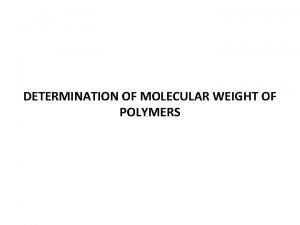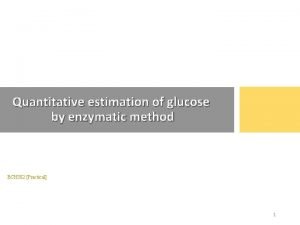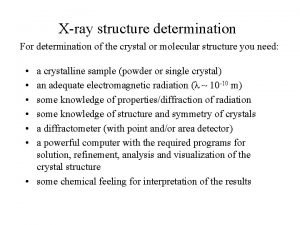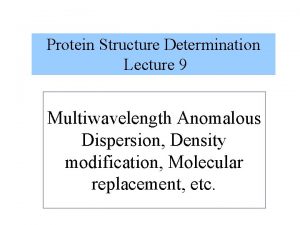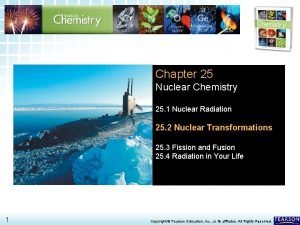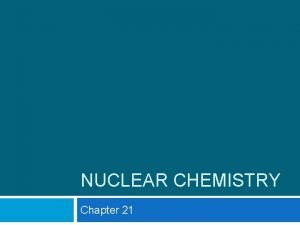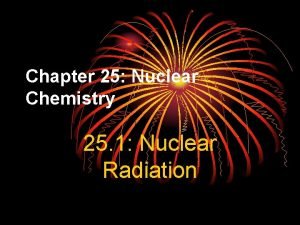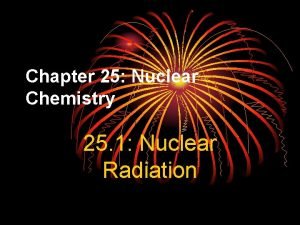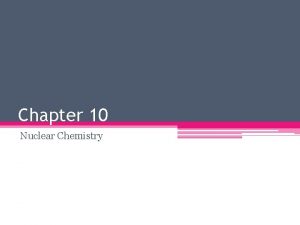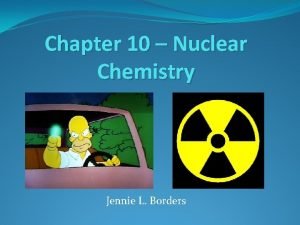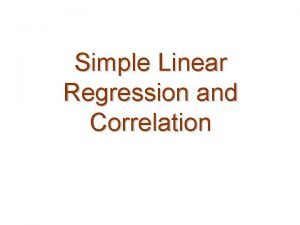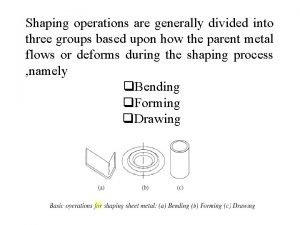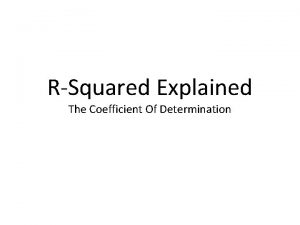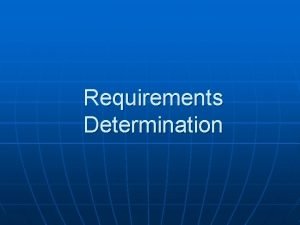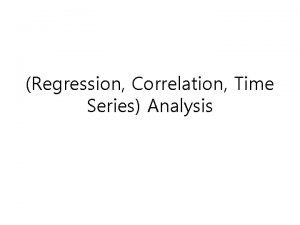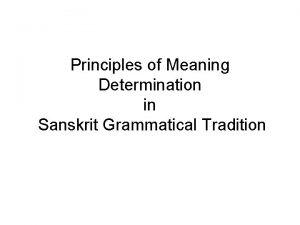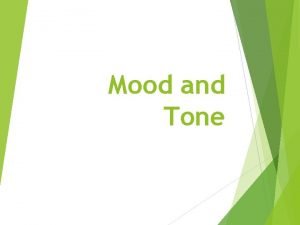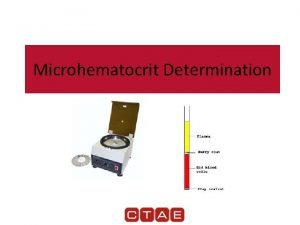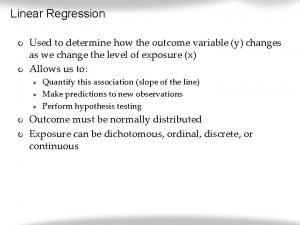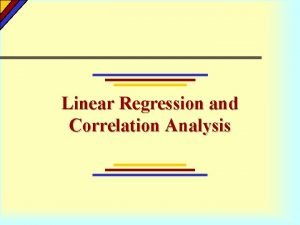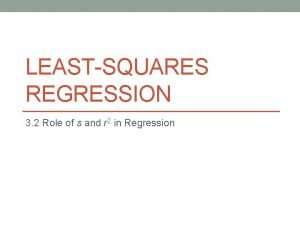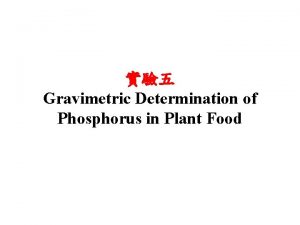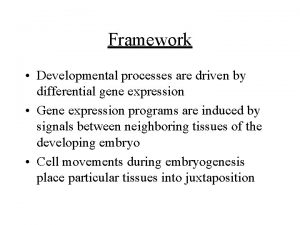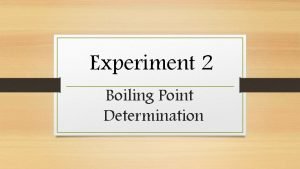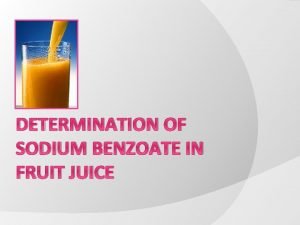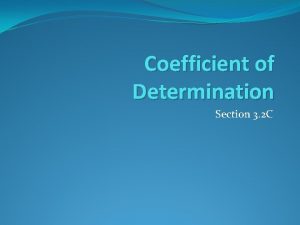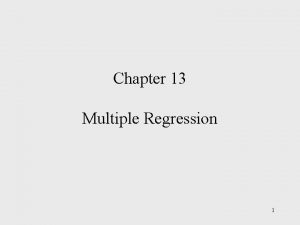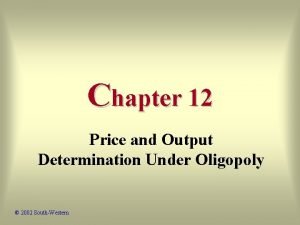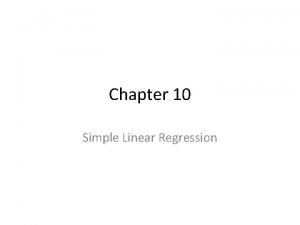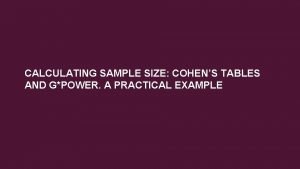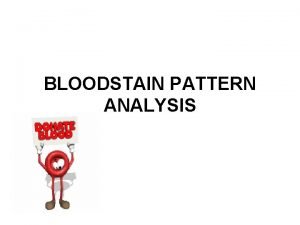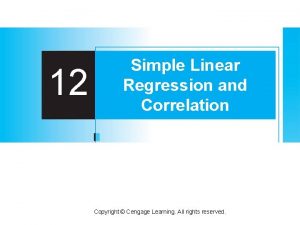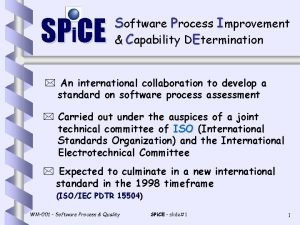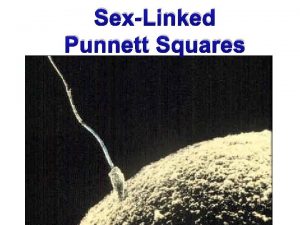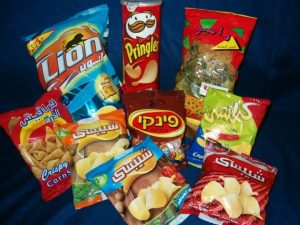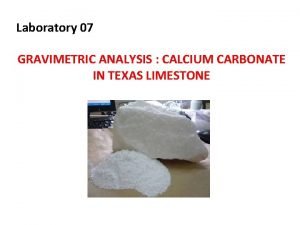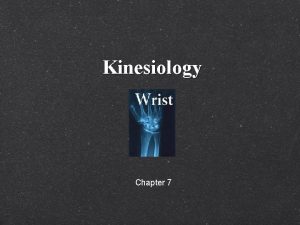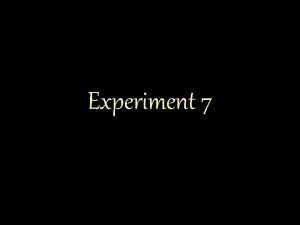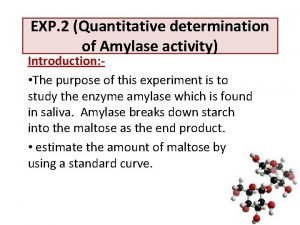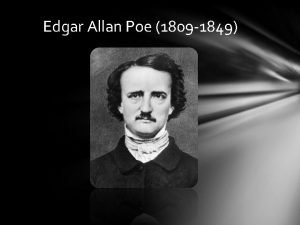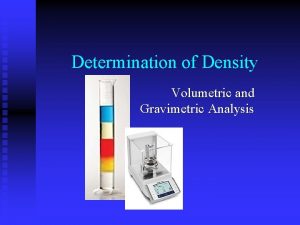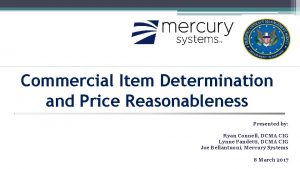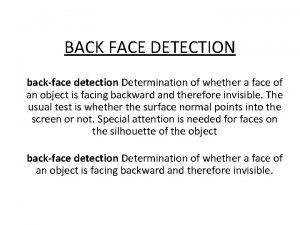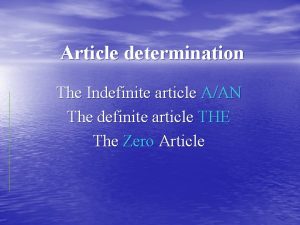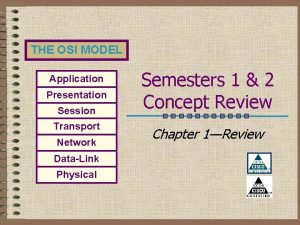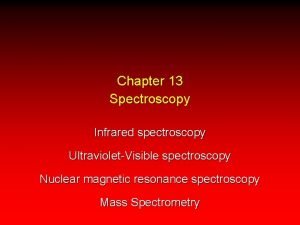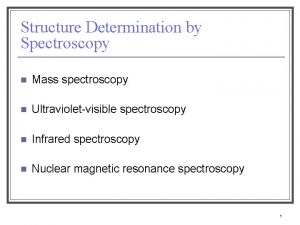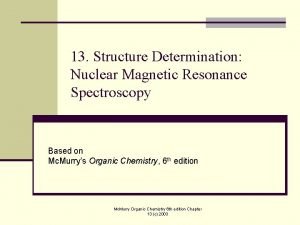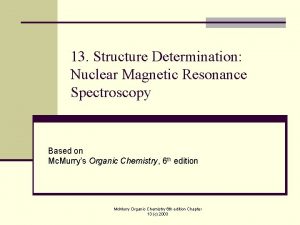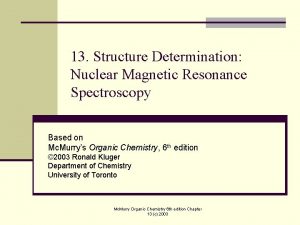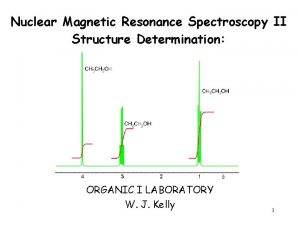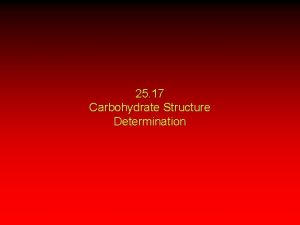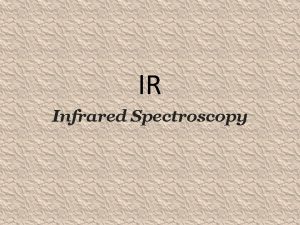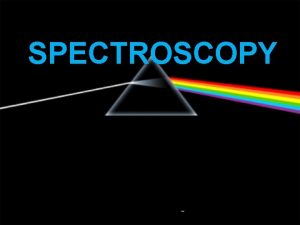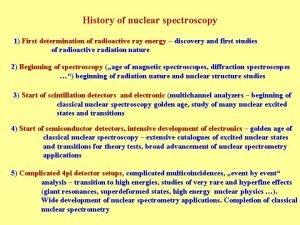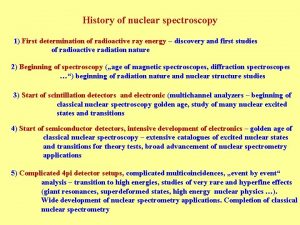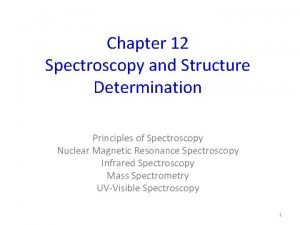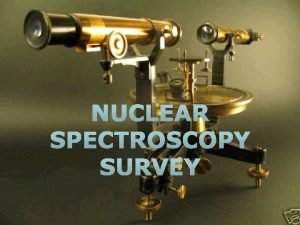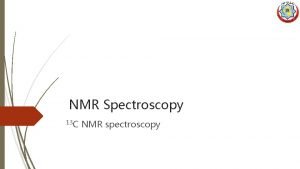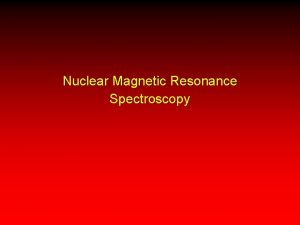Chapter 13 Spectroscopy Methods of structure determination Nuclear
















































































- Slides: 80

Chapter 13: Spectroscopy Methods of structure determination • Nuclear Magnetic Resonances (NMR) Spectroscopy (Sections 13. 3 -13. 19) • Infrared (IR) Spectroscopy (Sections 13. 20 -13. 22) • Ultraviolet-visible (UV-Vis) Spectroscopy (Section 13. 23) • Mass (MS) spectrometry (not really spectroscopy) (Section 13. 24) Molecular Spectroscopy: the interaction of electromagnetic radiation (light) with matter (organic compounds). This interaction gives specific structural information. 1

13. 24: Mass Spectrometry: molecular weight of the sample formula The mass spectrometer gives the mass to charge ratio (m/z), therefore the sample (analyte) must be an ion. Mass spectrometry is a gas phase technique- the sample must be “vaporized. ” Electron-impact ionization proton neutron electron 1. 00728 u 1. 00866 u 0. 00055 u 2

mass m = = charge z B 2 r 2 2 V B= magnetic field strength r = radius of the analyzer tube V= voltage (accelerator plate) Magnetic Field, Bo The Mass Spectrometer 3

Exact Masses of Common Natural Isotopes Isotope 1 H 2 H 12 C 13 C 14 N 15 N 16 O 17 O 18 O mass natural abundance Isotope mass natural abundance 1. 00782 2. 01410 99. 985 0. 015 19 F 18. 99840 35 Cl 12. 0000 13. 0033 98. 892 1. 108 (1. 11%) 37 Cl 34. 96885 36. 96590 75. 77 24. 23 (32. 5%) 14. 00307 15. 00010 99. 634 0. 366 (0. 38%) 81 Br 78. 91839 80. 91642 50. 69 49. 31 (98%) 15. 99491 16. 99913 17. 99916 99. 763 0. 037 (0. 04%) 0. 200 (0. 20%) 79 Br 127 I 126. 90447 100. 00 4

Molecular Ion (parent ion, M) = molecular mass of the analyte; sample minus an electron Base peak- largest (most abundant) peak in a mass spectra; arbitrarily assigned a relative abundance of 100%. m/z=78 (M+) (100%) m/z=79 (M+1) (~ 6. 6% of M+) 5

The radical cation (M+ • ) is unstable and will fragment into smaller ions m/z=15 Relative abundance (%) m/z=16 (M+) m/z=17 (M+1) m/z=14 Relative abundance (%) m/z=29 m/z=43 m/z=15 m/z=44 (M) m/z=45 (M+1) 6 m/z

35 Cl m/z=112 (M+) 37 Cl 34. 96885 36. 96590 75. 77 24. 23 (32. 5%) m/z=114 (M+ +2) m/z=77 m/z=113 (M+ +1) m/z=115 (M+ +3) m/z=77 79 Br m/z=156 (M+) m/z=157 (M+ +1) m/z=158 (M+ +2) 81 Br 78. 91839 80. 91642 50. 69 49. 31 (98%) m/z=159 (M+ +3) 7

Mass spectra can be quite complicated and interpretation difficult. Some functional groups have characteristic fragmentation It is difficult to assign an entire structure based only on the mass spectra. However, the mass spectra gives the mass and formula of the sample which is very important information. To obtain the formula, the molecular ion must be observed. Soft ionization techniques Methods have been developed to get large molecules such as polymers and biological macromolecules (proteins, peptides, nucleic acids) into the vapor phase 8

13. 25: Molecular Formula as a Clue to Structure Nitrogen rule: In general, “small” organic molecules with an odd mass must have an odd number of nitrogens. Organic molecules with an even mass have zero or an even number of nitrogens If the mass can be determined accurately enough, then the molecular formula can be determined (high-resolution mass spectrometry) Information can be obtained from the molecular formula: Degrees of unsaturation: the number of rings and/or -bonds in a molecule (Index of Hydrogen Deficiency) 9

Degrees of unsaturation saturated hydrocarbon cycloalkane (1 ring) alkene (1 -bond) alkyne (2 -bonds) Cn. H 2 n+2 Cn. H 2 n-2 For each ring or -bond, -2 H from the formula of the saturated alkane C 6 H 14 - C 6 H 12 H 2 1 2 2=1 Hydrogen Deficiency Degrees of Unsaturation C 6 H 14 - C 6 H 6 H 8 1 2 8=4 10

Correction for other elements: For Group VII elements (halogens): subtract 1 H from the H-deficiency for each halogen, For Group VI elements (O and S): No correction is needed For Group V elements (N and P): add 1 H to the H-deficiency for each N or P C 10 H 14 N 2 C 12 H 4 O 2 Cl 4 11

13. 1: Principles of molecular spectroscopy: Electromagnetic radiation organic molecule (ground state) light h organic relaxation organic + h molecule (excited state) (ground state) Electromagnetic radiation has the properties of a particle (photon) and a wave. = distance of one wave = frequency: waves per unit time (sec-1, Hz) c = speed of light (3. 0 x 108 m • sec-1) h = Plank’s constant (6. 63 x 10 -34 J • sec) 12

Quantum: the energy of a photon E = h = c h • c E= E (cm) short high Wavelength ( ) Frequency ( ) Energy (E) long low 13

13. 1: Principles of molecular spectroscopy: Quantized Energy Levels molecules have discrete energy levels (no continuum between levels) A molecule absorbs electromagnetic radiation when the energy of photon corresponds to the difference in energy between two states 14

organic molecule (ground state) light h organic relaxation organic + h molecule (excited state) (ground state) UV-Vis: valance electron transitions - gives information about -bonds and conjugated systems Infrared: molecular vibrations (stretches, bends) - identify functional groups Radiowaves: nuclear spin in a magnetic field (NMR) - gives a map of the H and C framework 15

13. 23 Ultraviolet-Visible (UV-Vis) Spectroscopy UV Vis 400 200 Recall bonding of a -bond from Chapter 10. 16 800 nm 16

-molecular orbitals of butadiene 4: 3 Nodes 0 bonding interactions 3 antibonding interactions ANTIBONDING MO 3: 2 Nodes 1 bonding interactions 2 antibonding interactions ANTIBONDING MO 2: 1 Nodes 2 bonding interactions 1 antibonding interactions BONDING MO 1: 0 Nodes 3 bonding interactions 0 antibonding interactions BONDING MO y 2 is the Highest Occupied Molecular Orbital (HOMO) 17 y 3 is the Lowest Unoccupied Molecular Orbital (LUMO)

UV-Vis light causes electrons in lower energy molecular orbitals to be promoted to higher energy molecular orbitals. HOMO LUMO Chromophore: light absorbing portion of a molecule 18

Molecular orbitals of conjugated polyenes 19

Molecules with extended conjugation move toward the visible region Color of absorbed light violet blue-green yellow orange red 400 nm 450 500 530 550 600 700 Color observed yellow orange red-violet blue-green 20

Many natural pigments have conjugated systems Chlorophyll anthocyanin -carotene lycopene 21

Chromophore: light absorbing portion of a molecule Beer’s Law: There is a linear relationship between absorbance and concentration A= cl A = absorbance c = concentration (M, mol/L) l = sample path length (cm) = molar absorptivity (extinction coefficient) a proportionality constant for a specific absorbance of a substance 22

13. 20: Introduction to Infrared Spectroscopy (cm) 1 E _ is expressed as (wavenumber), reciprocal cm (cm-1) _ _ 1 = therefore E IR radiation causes changes in a molecular vibrations 23

Stretch: change in bond length http: //www 2. chem. ucalgary. ca/Flash/photon. html Symmetric stretch Antisymmetric stretch Bend: change in bond angle scissoring rocking in-plane bend wagging twisting out-of-plane bend Animation of bond streches and bends: http: //wetche. cmbi. ru. nl//organic/vibr/methamjm. html 24

Bond Stretch: Hooke’s Law _ E f Hooke’s law simulation: http: //www 2. chem. ucalgary. ca/Flash/hooke. html 25

Interpretation of an Infrared Spectra: organic molecules contain many atoms. As a result, there are many stretching and bending modes. IR spectra have many absorption bands Four distinct regions of an IR spectra C-H O-H N-H C C C N C=C C=O 26

Fingerprint region (600 - 1500 cm-1)- low energy single bond stretching and bending modes. The fingerprint region is unique for any given organic compound. However, there are few diagnostic absorptions. Double-bond regions (1500 - 2000 cm-1) C=C 1620 - 1680 cm-1 C=O 1680 - 1790 cm-1 Triple-bond region: (2000 - 2500 cm-1) C C 2100 - 2200 cm-1 (weak, often not observed) C N 2240 - 2280 cm-1 X-H Single-bond region (2500 - 4000 cm-1) O-H 3200 - 3600 cm-1 (broad) CO-OH 2500 -3600 cm-1 (very broad) N-H 3350 - 3500 cm-1 C-H 2800 - 3300 cm-1 sp 3 -C-H 2850 - 2950 cm-1 sp 2 =C-H 3000 - 3100 cm-1 27 sp C-H 3310 - 3320 cm-1

13. 22 Characteristic Absorption Frequencies Table 13. 4, p. 554 Alkenes =C-H C=C Aromatic =C-H C=C Alkynes C-H C C Alcohols C-O O-H Amines C-N N-H Carbonyl C=O Carboxylic acids O-H Nitrile C N 3020 - 3100 cm-1 1640 - 1680 cm-1 medium - strong medium 3030 cm-1 1450 - 1600 cm-1 strong 3300 cm-1 2100 -2260 cm-1 strong weak - medium 1050 - 1150 cm-1 3400 - 3600 cm-1 strong and broad 1030 - 1230 cm-1 3300 - 3500 cm-1 medium 1670 - 1780 cm-1 strong 2500 - 3500 cm-1 strong and very broad 2240 - 2280 cm-1 weak-medium 28

% transmittance C C C-H % transmittance C-H cm-1 % transmittance hexane =C-H C=C C-H cm-1 C C C-H cm-1 29

CH 3(CH 2)4 CH 2 OH C N C-H H 3 C(H 2 C)4 CH 2 C N O-H C-O CH 3(CH 2)4 CH 2 NH-CH 3(CH 2)4 CH 2 NH 2 N-H C-H 30

O-H C=O 1705 cm-1 C-H C=O 1730 cm-1 C=O 1710 cm-1 C-H C=O 1715 cm-1 31

32

13. 3: Introduction to 1 H NMR direct observation of the H’s of a molecules Nuclei are positively charged and spin on an axis; they create a tiny magnetic field Not all nuclei are suitable for NMR. 1 H and 13 C are the most important NMR active nuclei in organic chemistry Natural Abundance 1 H 99. 9% 13 C 1. 1% 12 C 98. 9% (not NMR active) 33

(a) Normally the nuclear magnetic fields are randomly oriented (b) When placed in an external magnetic field (Bo), the nuclear magnetic field will either aligned with (lower energy) or oppose (higher energy) the external magnetic field Fig 13. 3, p. 520 34

The energy difference between aligned and opposed to the external magnetic field (Bo) is generally small and is dependant upon Bo Applied EM radiation (radio waves) causes the spin to flip and the nuclei are said to be in resonance with Bo Bo = external magnetic field strength g = gyromagnetic ratio 1 H= 26, 752 13 C= 6. 7 is a constant and is sometimes denoted as h 35 g. Bo h DE = h DE = 2 Note that h 2

NMR Active Nuclei: nuclear spin quantum number (I) atomic mass and atomic number Number of spin states = 2 I + 1 (number of possible energy levels) Even mass nuclei that have even number of neutron have I = 0 (NMR inactive) Even mass nuclei that have odd number of neutrons have an integer spin quantum number (I = 1, 2, 3, etc) Odd mass nuclei have half-integer spin quantum number (I = 1/2, 3/2, 5/2, etc) I= 1/2: 1 H, 13 C, 19 F, 31 P I= 1: 2 H, 14 N I= 3/2: 15 N I= 0: 12 C, 16 O 36

Continuous wave (CW) NMR Pulsed (FT) NMR 37

13. 4: Nuclear Shielding and 1 H Chemical Shift Different nuclei absorb EM radiation at different wavelength (energy required to bring about resonance) Nuclei of a given type, will resonate at different energies depending on their chemical and electronic environment. The position (chemical shift, ) and pattern (splitting or multiplicity) of the NMR signals gives important information about the chemical environment of the nuclei. The integration of the signal is proportional to the number of nuclei giving rise to that signal 38

Chemical shift: the exact field strength (in ppm) that a nuclei comes into resonance relative to a reference standard (TMS) Electron clouds “shield” nuclei from the external magnetic field causing them to resonate at slightly higher energy Shielding: influence of neighboring functional groups on the electronic structure around a nuclei and consequently the chemical shift of their resonance. Tetramethylsilane (TMS); Reference standard = 0 for 1 H NMR downfield lower magnetic field less shielded (deshielded) H–CCl 3 = 7. 28 ppm upfield higher magnetic field more shielded TMS 39 Chemical shift ( , ppm)

downfield lower magnetic field less shielded (deshielded) N CCH 2 OCH 3 = 4. 20 ppm 2 H = 3. 50 ppm 3 H upfield higher magnetic field more shielded TMS Chemical shift ( , ppm) Vertical scale= intensity of the signal Horizontal scale= chemical shift ( ), dependent upon the field strength of the external magnetic field; for 1 H, is usually from 1 -10 ppm - TMS chemical shift in Hz operating frequency in MHz 14, 100 gauss: 60 MHz for 1 H (60 million hertz) ppm= 60 Hz 15 MHz for 13 C 140, 000 gauss: 600 MHz for 1 H ppm = 600 Hz 40 150 MHz for 13 C

13. 5: Effect of Molecular Structure on 1 H Chemical Shift Electronegative substituents deshield nearby protons less shielded more shielded H 3 C-F H 3 C-O-CH 3 (H 3 C)3 -N H 3 C-CH 3 (H 3 C)4 -Si 4. 3 3. 2 2. 2 0. 9 0. 0 The deshielding effect of a group drops off quickly with distance (number of bonds between the substituent and the proton) H 3 C-H 2 C-H 2 C-O-CH 2 -CH 3 1. 37 3. 40 0. 92 1. 55 41

The influence of neighboring groups (deshielding) on 1 H chemical shifts is cumulative = 7. 3 5. 3 = 2. 1 4. 06 3. 1 ppm 5. 96 ppm 42

Typical 1 H NMR chemical shifts ranges; additional substitution can move the resonances out of the range also see Table 13. 1 (p. 526) 43

Protons attached to sp 2 and sp hybridize carbons are deshielded relative to protons attached to sp 3 hybridized carbons = 9. 7 7. 3 5. 3 2. 1 0. 9 -1. 5 ppm Please read about ring current effects of -bonds (Figs. 13. 8 -13. 10, p. 527 -9) = 2. 3 - 2. 8 1. 5 - 2. 6 2. 1 -2. 5 ppm 44

13. 6: Interpreting 1 H NMR Spectra Equivalence (chemical-shift equivalence): chemically and magnetically equivalent nuclei resonate at the same energy and give a single signal or pattern = 4. 20 ppm 2 H = 3. 50 ppm 3 H TMS 45

46

Test of Equivalence: 1. Do a mental substitution of the nuclei you are testing with an arbitrary label 2. Ask what is the relationship of the compounds with the arbitrary label 3. If the labeled compounds are identical (or enantiomers), then the original nuclei are chemically equivalent and do not normally give rise to a separate resonance in the NMR spectra If the labeled compounds are not identical (and not enantiomers), then the original nuclei are not chemically equivalent and can give rise to different resonances in the NMR spectra Identical, so the protons are equivalent Identical, so the methyl groups are equivalent 47

These are geometric isomers (not identical and not enantiomers). The three methyl groups are therefore not chemically equivalent and can give rise to different resonances 48

49

Homotopic: equivalent Enantiotopic: equivalent Diastereotopic: non-equivalent 50

Integration of 1 H NMR resonances: The area under an NMR resonance is proportional to the number of equivalent nuclei that give rise to that resonance. = 4. 20, 2 H = 3. 50, 3 H TMS The relative area under the resonances at = 4. 20 and 3. 50 is 2: 3 51

13. 7: Spin-spin splitting in 1 H NMR spectroscopy protons on adjacent carbons will interact and “split” each others resonances into multiple peaks (multiplets) n + 1 rule: equivalent protons that have n equivalent protons on the adjacent carbon will be “split” into n + 1 peaks. d= 2. 0 3 H d= 1. 2 3 H d= 4. 1 2 H Resonances always split each other. The resonance at = 4. 1 splits the resonance at = 1. 2; therefore, the resonance at = 1. 2 must split the resonance at = 4. 2. 52

The multiplicity is defined by the number of peaks and the pattern (see Table 13. 2 for common multiplicities patterns and relative intensities) d= 2. 0 s, 3 H d= 1. 2 t, 3 H d= 4. 1 q, 2 H 1: 2: 1 1: 3: 3: 1 53

The resonance of a proton with n equivalent protons on the adjacent carbon will be “split” into n + 1 peaks with a coupling constant J. Coupling constant: distance between peaks of a split pattern; J is expressed in Hz. Protons coupled to each other have the same coupling constant J. d= 2. 0 s, 3 H d= 1. 2 t, J=7. 2 Hz, 3 H d= 4. 1 q, J=7. 2 Hz, 2 H 54

13. 8: Splitting Patterns: The Ethyl Group Two equivalent protons on an adjacent carbon will split a proton a triplet (t), three peaks of 1: 2: 1 relative intensity Three equivalent protons on an adjacent carbon will split a proton into a quartet (q), four peaks of 1: 3: 3: 1 relative intensity = 3. 0, q J= 7. 2, 2 H = 1. 2, t J= 7. 0, 3 H = 7. 4 -7. 1, m, 5 H = 2. 6, q, J= 7. 0, 2 H = 1. 2, t J= 7. 2, 3 H = 8. 0, 2 H = 7. 6 -7. 3, m, 3 H 55

13. 8: Splitting Patterns: The Isopropyl Group One proton on an adjacent carbon will split a proton into a doublet (d), two peaks of 1: 1 relative intensity Six equivalent protons on an adjacent carbon will split a proton into a septet (s), seven peaks of 1: 6: 15: 20: 15: 6: 1 relative intensity = 1. 2, d J= 6. 9, 6 H = 7. 4 -7. 1, m, 5 H = 2. 9, s, J= 6. 9, 1 H = 8. 1, d, J= 6. 1 Hz, 2 H = 7. 4, d J= 6. 1 Hz, 2 H = 3. 0, s, J= 6. 9, 1 H 56

13. 10: Splitting Patterns: Pairs of Doublets = 1. 2, s, 9 H = 8. 0, d, J= 9. 0 2 H = 7. 4, d, J= 9. 0 2 H = 3. 9, s, 3 H fig 13. 19, p. 537 57

13. 11: Complex Splitting Patterns: when a protons is adjacent to more than one set of non-equivalent protons, they will split independently J 1 -2 = 7. 0 J 2 -3 = 16. 0 H 2 splits H 3 into a doublet with coupling constant J 2 -3 = 16. 0 H 2 splits H 1 into a doublet with coupling constant J 1 -2 = 7. 0 H 1 splits H 2 into a doublet with a coupling constants J 1 -2 =7. 0; H 3 further splits H 2 into a doublet (doublet of doublets) with coupling constants J 2 -3 = 16. 0 58

= 0. 9, t, J = 7. 4, 3 H = 2. 6, 2 H = 1. 6, 2 H 59

13. 12: 1 H NMR Spectra of Alcohols Usually no spin-spin coupling between the O–H proton and neighboring protons on carbon due to exchange reaction The chemical shift of the -OH proton occurs over a large range (2. 0 - 5. 5 ppm). This proton usually appears as a broad singlet. It is not uncommon for this proton not to be observed. 13: NMR and Conformation (please read) NMR is like a camera with a slow shutter speed. What is observed is a weighted time average of all conformations 60 present.

Summary of 1 H-1 H spin-spin coupling • chemically equivalent protons do not exhibit spin-spin coupling to each other. • the resonance of a proton that has n equivalent protons on the adjacent carbon is split into n+1 peaks (multiplicity) with a coupling constant J. • protons that are coupled to each other have the same coupling constant • non-equivalent protons will split a common proton independently: complex coupling. Spin-spin coupling is normally observed between nuclei that are one, two and three bonds away. Four-bond coupling can be observed in certain situations (i. e. , aromatic rings), but is not common. 61

Summary of 1 H-NMR Spectroscopy • the number of proton resonances equals the number of non-equivalent protons • the chemical shift ( , ppm) of a proton is diagnostic of the chemical environment (shielding and deshielding) • Integration: number of equivalent protons giving rise to a resonance • spin-spin coupling is dependent upon the number of equivalent protons on the adjacent carbon(s) 62

13 C NMR Spectroscopy: Natural Abundance 1 H 99. 9% (I= 1/2) DE= g. Bo h 2 13 C 12 C 98. 9% (I= 0) 13 C 1. 1% (I= 1/2) Bo = external magnetic field strength g = magnetogyric ratio 1 H= 26, 752 13 C= 6. 7 is a much less sensitive nuclei than 1 H for NMR spectroscopy New techniques (hardware and software) has made 13 C NMR routine • Pulsed NMR techniques (FT or time domain NMR) • Signal averaging (improved signal to noise) Animation: http: //mutuslab. cs. uwindsor. ca/schurko/nmrcourse/animations/eth_anim/puls_evol. gif 63

Fourier Transform (FT) deconvolutes all of the FID’s and gives an NMR spectra. time Signal-averaging: pulsed NMR allows for many FID’s (NMR spectra) to be accumulated over time. These FID’s are added together and averaged. Signals (resonances) build up while the “noise” is random and cancels out during the averaging. Enhanced signal to noise ratio and allows for NMR spectra to be collected on insensitive nuclei such as 13 C and small samples. 13 C-spectra of CH 3 CH 2 CH 2 OH after one scan average of 200 scans 64

Chemical shifts give an idea of the chemical and electronic environment of the 13 C nuclei due to shielding and deshielding effects range: 0 - 220 ppm from TMS 13 C NMR spectra will give a map of the carbon framework. The number of resonances equals the number of non-equivalent carbons. 132. 8 128. 5 137. 1 128. 0 128. 5 132. 8 17. 8 13. 9 40. 5 200. 3 137. 1 CDCl 3 TMS 65

Chemical Shift Range of 13 C Note the carbonyl range 66

13. 18: Using DEPT to Count Hydrogens Attached to 13 C 1 H-13 C spin-spin coupling: spin-spin coupling tells how many protons are attached to the 13 C nuclei. (i. e. , primary, secondary tertiary, or quaternary carbon) 13 C spectra are usually collected with the 1 H-13 C coupling “turned off” (broad band decoupled). In this mode all 13 C resonances appear as singlets. DEPT spectra (Distortionless Enhancement by Polarization Transfer) a modern 13 C NMR spectra that allows you to determine the number of attached hydrogens. 67

3 Broad-band decoupled 5 2 4 8 7 1 6 DEPT CH CH 3 CH 2’s give negative resonances CH’s and CH 3’s give positive resonances Quaternary carbon (no attached H’s) are not observed 13. 19: 2 D NMR: COSY and HETCOR (please read) 68

Solving Combined Spectra Problems: Mass Spectra: Molecular Formula Nitrogen Rule # of nitrogen atoms in the molecule M+1 peak # of carbons Degrees of Unsaturation: # of rings and/or -bonds Infrared Spectra: Functional Groups C=O O-H C=C N-H C C CO-OH C N 1 H NMR: Chemical Shift ( ) chemical environment of the H's Integration # of H's giving rise to the resonance Spin-Spin Coupling (multiplicity) # of non-equivalent H's on the adjacent carbons (vicinal coupling). 13 C NMR: # of resonances symmetry of carbon framework Type of Carbonyl Each piece of evidence gives a fragment (puzzle piece) of the structure. Piece the puzzle together to give a proposed structure. The proposed structure should be consistent with all the evidence. 69

13. 41 (Fig 14. 45 (p. 572) 70

Problem 13. 42 (Fig. 14. 46, p. 573) 71

13. 43 (Fig. 13. 47, p. 574): C 5 H 10 O 13 C NMR: 7. 9 35. 5 212. 1 72

C 10 H 14 127. 0 128. 2 125. 7 31. 2 41. 7 21. 8 12. 3 147. 6 = 2. 61 (d, 3 H) = 2. 61 (sextet, J=7, 1 H) = 2. 61 (t, 3 H) = 2. 61 (pentet, J=7, 2 H) = 7. 4 -7. 1 (m, 5 H) 73

%T 15. 14 Spectroscoic Analysis of Alcohols and Thiols: Infrared (IR): Characteristic O–H stretching absorption at 3300 to 3600 cm 1 Sharp absorption near 3600 cm-1 except if H-bonded: then broad absorption 3300 to 3400 cm 1 range Strong C–O stretching absorption near 1050 cm 1 O-H C-O 74 cm-1

1 H NMR: protons attached to the carbon bearing the hydroxyl group are deshielded by the electron-withdrawing nature of the oxygen, 3. 3 to 4. 7 = 1. 5, q, 2 H = 3. 65, t, 2 H = 0. 9, d, 3 H = 1. 7, = 2. 25, m, 1 H br s, 1 H 61. 2 41. 7 24. 7 22. 6 CDCl 3 O-H C-O 75

Usually no spin-spin coupling between the O–H proton and neighboring protons on carbon due to exchange reaction The chemical shift of the -OH proton occurs over a large range (2. 0 - 5. 5 ppm). It chemical shift is dependent upon the sample concentration and temperature. This proton is often observed as a broad singlet (br s). Exchangable protons are often not to be observed at all. 76

13 C NMR: The oxygen of an alcohol will deshield the carbon it is attached to. The chemical shift range is 50 -80 ppm 14 19 35 62 CH 3 — CH 2 — OH DMSO-d 6 (solvent) 77

15. 48 (fig 15. 8, p. 658) 13 C: 138. 6 129. 4 128. 4 126. 3 68. 8 45. 8 22. 7 145. 2 128. 8 127. 8 126. 5 76. 3 32. 3 10. 6 78

Magnetic Resonance Imaging (MRI): uses the principles of nuclear magnetic resonance to image tissue MRI normally uses the magnetic resonance of protons on water and very sophisticated computer methods to obtain images. Other nuclei within the tissue can also be used (31 P) or a imaging (contrast) agent can be administered 79

MRI images Normal 25 years old Normal 86 years old Alzheimer’s Disease 78 years old f. MRI: 80
 Lesson 15 nuclear quest nuclear reactions
Lesson 15 nuclear quest nuclear reactions Fisión nuclear vs fision nuclear
Fisión nuclear vs fision nuclear End group analysis
End group analysis Enzymatic methods for glucose determination
Enzymatic methods for glucose determination X-ray structure determination
X-ray structure determination Protein structure determination
Protein structure determination Wax pattern in dentistry
Wax pattern in dentistry Chapter 24: nuclear chemistry answer key
Chapter 24: nuclear chemistry answer key Chapter 25 nuclear chemistry answer key
Chapter 25 nuclear chemistry answer key Chapter 21 review nuclear chemistry
Chapter 21 review nuclear chemistry Chapter 25 nuclear chemistry
Chapter 25 nuclear chemistry Chapter 25 nuclear chemistry
Chapter 25 nuclear chemistry Chapter 10 nuclear chemistry
Chapter 10 nuclear chemistry Chapter 10 nuclear chemistry
Chapter 10 nuclear chemistry Linear regression riddle a answer key
Linear regression riddle a answer key Blank determination example
Blank determination example X linked recessive punnett square
X linked recessive punnett square Brain pop sex ed
Brain pop sex ed Sex determination in drosophilla
Sex determination in drosophilla Self advocate
Self advocate Sample size determination
Sample size determination Shipping point determination
Shipping point determination Shipping point determination sap
Shipping point determination sap What does the coefficient of determination tell us
What does the coefficient of determination tell us Requirement determination example
Requirement determination example Coefficient of determination in r
Coefficient of determination in r Determination and description of material quality
Determination and description of material quality Metodo di lowry
Metodo di lowry Determination in sanskrit
Determination in sanskrit Super normal profit meaning
Super normal profit meaning Mood tone
Mood tone Grit personality trait
Grit personality trait How to read microhematocrit reader
How to read microhematocrit reader Coefficient of determination interpretation
Coefficient of determination interpretation Example of regression analysis
Example of regression analysis Calculation of coefficient of determination
Calculation of coefficient of determination Gravimetric determination of phosphorus in plant food
Gravimetric determination of phosphorus in plant food Differentiation vs determination
Differentiation vs determination Manifestation meeting for 504
Manifestation meeting for 504 Boiling point determination experiment
Boiling point determination experiment What is kohlrausch law and its applications
What is kohlrausch law and its applications Determination of sodium benzoate in fruit juice
Determination of sodium benzoate in fruit juice Calculate the coefficient of determination
Calculate the coefficient of determination Principle of slide method of clotting time
Principle of slide method of clotting time Is determination a character trait
Is determination a character trait Personal services business determination
Personal services business determination Significance f
Significance f Prediction interval formula
Prediction interval formula Price and output determination under oligopoly
Price and output determination under oligopoly Calculation of coefficient of determination
Calculation of coefficient of determination Cohen sample size
Cohen sample size Medium velocity blood spatter
Medium velocity blood spatter Manifestation determination flowchart
Manifestation determination flowchart Manifestation determination flowchart
Manifestation determination flowchart Center for change in transition
Center for change in transition Uniform determination of death act (udda)
Uniform determination of death act (udda) Sex determination and sex linkage
Sex determination and sex linkage Coefficient of determination formula in regression
Coefficient of determination formula in regression Traditional methods for determining requirements
Traditional methods for determining requirements Air self determination scale
Air self determination scale Software process improvement and capability determination
Software process improvement and capability determination Family punnett square
Family punnett square North carolina residency determination service
North carolina residency determination service Price determination under perfect competition
Price determination under perfect competition Loyalty quotes in the odyssey
Loyalty quotes in the odyssey Ash content determination
Ash content determination Gravimetric determination of calcium lab report
Gravimetric determination of calcium lab report Radius side determination
Radius side determination Tool marks forensics
Tool marks forensics Nasal silling
Nasal silling Gravimetric analysis principle
Gravimetric analysis principle Amylase activity calculation formula
Amylase activity calculation formula Transport number in chemistry
Transport number in chemistry Poe
Poe Manifestation determination definition
Manifestation determination definition Gravimetric determination of chloride lab report conclusion
Gravimetric determination of chloride lab report conclusion Commercial item definition
Commercial item definition Face of determination
Face of determination Back titration of aspirin
Back titration of aspirin Article on determination
Article on determination Application presentation session transport network
Application presentation session transport network


